In This Episode: I’m recording this episode the evening of July 20th: the 50th anniversary of the first humans landing on the moon. If you think it maybe took Uncommon Sense to get there, you’re right: it took an extraordinary amount, and this episode talks about some of the details that you may not have heard about before.
038: The Giant Leap for Mankind
How to Subscribe and List of All Episodes
Show Notes
- Help Support Uncommon Sense — yes, $5 helps!
- NASA budget information (historical through 2017) is here. The military budget info is from here and here.
- The several photos noted are interspersed in the transcript.
- Errata Note: I said at the time of Kennedy’s go-to-the-moon challenge, humanity had less than 2 hours of experience in space. It’s actually barely over 2 hours. (The most important number in this context remains the same: the U.S. was publicly making this challenge to itself after it had a single manned space flight that lasted a mere 15 minutes!
Transcript
Welcome to Uncommon Sense. I’m Randy Cassingham.
When President John F. Kennedy announced the goal, “before this decade is out, of landing a man on the Moon and returning him safely to the Earth,” there certainly wasn’t a universal feeling of that being a great goal, even from Americans. The war in Vietnam was raging, and so were civil rights protests. And NASA wasn’t even sure it could be done.
When Kennedy gave that proposal as a speech to Congress on May 25, 1961, humankind — and I mean the Russians and Americans combined — had a total experience of less than two hours of human flight in space: 108 minutes by the USSR’s Yuri Gagarin, and a mere 15 minutes by American Alan Shepard, who had flown just 20 days prior to that speech. Russia was certainly not going to give us any lessons learned from their efforts: the whole thing was known as a “space race” — and landing humans on the moon was the biggest possible goal available at the time …and Russia was in the lead.
Flying to the moon and back wasn’t an order of magnitude more complex than Freedom 7’s suborbital flight: it was multiple orders of magnitude more complex, especially with JFK’s added difficulty factor: we have to return those guys to Earth “safely”!
So how did we do it? First, NASA was given enough money to do it. You often hear about the huge cost of the Apollo program, but NASA’s budget peaked out at just 4.4 percent of the federal budget, in 1966. By comparison, today NASA’s budget is less than one-half of one percent of the federal budget. By the way, in 2015 — the most recent figures I could find — our military spending was just shy of 16 percent of the entire budget, and is more than the next seven countries combined.
Still, that meant NASA was able to hire lots of engineers: they could hire Uncommon Sense, and the project was interesting enough that those engineers were willing to take government salaries.
But what was it they had to invent? It wasn’t just rockets, even though that technology was complex enough all by itself.
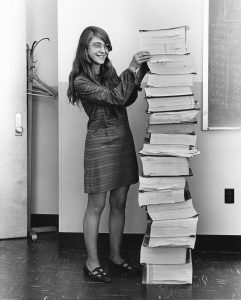
They knew they’d need computers, and they certainly had them. But they also desperately needed something that hadn’t been invented at that time: software engineering. You may have heard of Margaret Hamilton: she’s had some great press over the past few years, mostly centered around a photograph of her standing next to a printout of the software for Apollo, most of which she wrote. She was the director of what became the Software Engineering Division of the MIT Instrumentation Laboratory, leading the team that developed the on-board flight software for NASA’s Apollo space program. When she started on the project in 1963, Hamilton was 26 years old.
And she’s the one who is credited with popularizing the term “software engineering.” “Software during the early days of [Apollo] was treated like a stepchild and not taken as seriously as other engineering disciplines, such as hardware engineering,” Hamilton said later, even though, or perhaps because, MIT was such an established engineering center. “It was regarded as an art and as magic, not a science,” she continued. “I began to use the term ‘software engineering’ to distinguish it from hardware and other kinds of engineering.” It took years for the term to take hold.
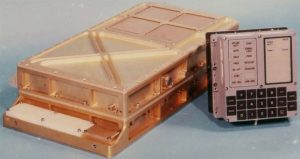
And what sort of computer might that engineered software run on? At the time, computers were giant things that filled rooms. Even a “small” computer was the size of a household refrigerator. They needed something small and light to go onto the tiny and primitive spacecraft. MIT was developing the software, but they also developed the hardware in parallel. The result was the Apollo Guidance Computer, or AGC. The interface was called the DSKY, short for display and keyboard, and it was a marvel in itself. The Show Page has a photo.
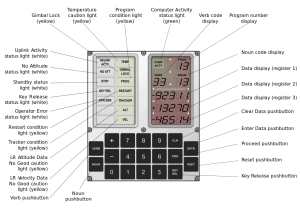
The AGC had to juggle 200 different inputs and outputs, taking in data from sensors, radar, and uploaded information from Mission Control in Houston. It could control the spacecraft engines and attitude thrusters, and had to keep track of exactly where the ship was in relation to Earth and the moon, all the while displaying what was up to the astronauts via the DSKY. If it failed, there would be no way to recover the astronauts: they would die in space. It had to figure out what tasks were the most important and do those first — which wasn’t something computers ever had to do before.
Oh, and on top of all of that: it couldn’t really be fully tested until it was on a spacecraft, flying in space. It had to be operated not by computer scientists in white coats, but by test pilots-turned-astronauts wearing bulky spacesuits with clumsy gloves punching information onto the DSKY. The AGC also had to be able to recover by itself in case of any failure: rebooting and picking up where it left off, and do it quickly. That was in the 1960s: can your computer do that now, in the 20-teens?! And by the way: it did it all with just 73 kilobytes of memory — memory that was hand-made.
And that fault tolerance proved to be necessary. Remember that while Apollo 11’s Eagle was landing, the computer was throwing errors? 1201 and 1202 alarms: overloaded, in part because the command module rendezvous radar was still on, which wasn’t needed during the landing phase, but was supposed to be kept on standby in case of an abort, which meant they’d have to go back and rendezvous with the command module. But here’s the thing: the computer was working exactly as designed: when Buzz Aldrin commanded the computer to calculate the “Delta-H” — the difference between the computer’s calculated altitude and the landing radar’s measured altitude — that was enough to cause the overflow with all that going on.
So the computer displayed the error as it threw out the lower priority Delta-H calculation so it could do the higher-priority approach calculations and engine thrust control.
And here’s how well that computer software and hardware worked: over 11 Apollo missions, including the nine that flew to the moon and back, 2,504 hours of space flight, there was not one documented software or hardware fault. The perfect performance of the computer engineering absolutely made Apollo possible.
The second big piece of the puzzle I’ll talk about today is something else we take for granted today. So we have humans out in space in a specific direction and we not only need to talk to them at all times, but they’re sending back video streams so that hundreds of millions of people all around the world can watch, live.
Yet Earth is spinning on its axis: the moon certainly isn’t visible from Houston, Texas, 24 hours a day, so how could Mission Control talk to them after the moon sets, until it rises again later? You might think “satellites,” but they were pretty primitive in the 1960s too.
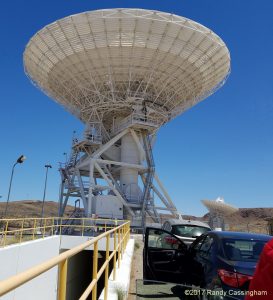
Enter the Manned Space Flight Network. Because everything in NASA has to have an acronym, they called it MSFN. NASA already had the Deep Space Network, operated by the Jet Propulsion Laboratory for unmanned spacecraft, and that was used also, but MSFN antennas were located in several spots around the world, including on ships in the ocean, so that at any particular time during the Earth’s 24-hour rotation, at least one would have a clear view toward the moon. JPL had a big part of this since they already had a fair amount of experience communicating with spacecraft beyond Earth orbit with the DSN.
There was also the Spacecraft Tracking and Data Network, though STDN wasn’t anywhere near as pronounceable as MSFN. STDN was mostly used for spacecraft in Earth orbit, but expanded greatly to support the Apollo missions that went beyond low Earth orbit.
But just having the antennas — the radio communication system — wasn’t enough: they had to be connected to each other, and to Mission Control in Houston, and also be able to feed signals to television networks all around the world. They needed data transmission. A perfect use of the Internet …but that didn’t exist yet either.
Even though the system was heavily computerized, thanks to 39 Univac mainframes installed around the world, the system required 2,700 people to keep it all going. They used two million miles of leased communication lines and two satellites to connect it all together, and this was in the era of multi-dollar 3-minute long-distance phone calls; the phone bill for it all was $70 million per year.
The data rate of the voice, video, and telemetry coming down from the spacecraft was around 51,000 bits per second. As per usual, upload wasn’t as fast: about 2,000 bits per second, but mostly they just needed to send voice, though they could upload some data to the Apollo computer, too.
It was all designed and operated by NASA’s Goddard Spaceflight Center in Greenbelt, Maryland, just outside Washington, D.C., and then piped to Mission Control in Houston via a dedicated circuit running at 40,800 bits per second. Remember, this is the 1960s, but it still took nearly 30 years for home-based computer modems to beat that rate!
Once on the moon, the astronauts were scheduled to sleep for five hours before going out for their walk, moon rock collection, and setting up several scientific instruments. But hey: if you were the first man on the moon, the culmination of work by 300,000 people working full time for years to get you there, would you be able to sleep? So they decided to do it all early.
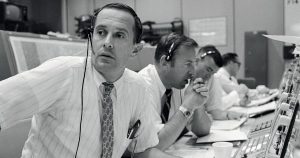
Apollo 11’s Eagle lunar module had landed on July 20 at 20:17 Coordinated Universal Time, or UTC, which was the new name for what many still called Greenwich Mean Time. They had plenty to do before their scheduled rest period. They didn’t use all five rest hours after their work was done, so Neil Armstrong stepped onto the moon’s surface six hours and 39 minutes later, at 02:56 UTC, which was 9:56 P.M. in Houston. A lot of kids were awakened by their parents to come watch. I was still up: I lived in California, and even though I was pretty young, we had been watching it all on TV all evening, and it was not quite 8:00 P.M.
And the video of that moment and the radio transmissions from the moon were received at the Honeysuckle Creek Tracking Station near Canberra, Australia. As the Earth rotated, communications were switched to the larger Parkes radio telescope in New South Wales, Australia. And thanks to the first worldwide data network built for $370 million, everyone in the world in range of a TV set could watch live, and hear those words capping America’s victory in the space race: “That’s one small step for man, one giant leap for mankind.”
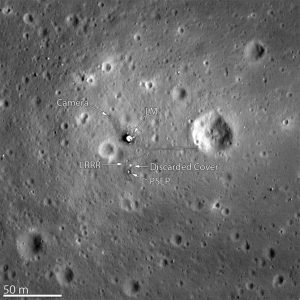
Meanwhile, during the missions, most of the time the tracking systems on Earth could pinpoint each spacecraft’s position during flight to within 30 feet, and measure their velocity to within 1 mile per hour, and report it on a console at Mission Control on command.
Now that’s a data network. And just a couple of examples why I say that when you really, really need Uncommon Sense, if you have enough money, you can rent it and make truly incredible things happen.
The Show Page for this episode with several photos and links are at thisistrue.com/podcast38, and you’re also welcome to comment there. That’s possible because some of the technology of the Internet has the Spacecraft Tracking and Data Network as an ancestor. A lot of things were invented to make Apollo happen. All the money spent on Apollo was spent right here on Earth, and we’re still benefiting from thousands of spinoffs that make life on Earth better. That’s Uncommon Sense in action.
I’m Randy Cassingham … and I’ll talk at you later.
Note: Part One to this story is the previous blog entry: One Small Step for [a] Man
Also related: Dinner with Neil Armstrong
– – –
Bad link? Broken image? Other problem on this page? Use the Help button lower right, and thanks.
This page is an example of my style of “Thought-Provoking Entertainment”. This is True is an email newsletter that uses “weird news” as a vehicle to explore the human condition in an entertaining way. If that sounds good, click here to open a subscribe form.
To really support This is True, you’re invited to sign up for a subscription to the much-expanded “Premium” edition:
Q: Why would I want to pay more than the minimum rate?
A: To support the publication to help it thrive and stay online: this kind of support means less future need for price increases (and smaller increases when they do happen), which enables more people to upgrade. This option was requested by existing Premium subscribers.

I always was amazed that I could watch the moon landing from a state-park meadow near Couer d’Alene, Idaho, at the National Boy Scout Jamboree. Of course, my memory has been refreshed countless times with ever-deepening understanding of what actually happened and how. Thanks to Margaret, and MIT, and the Aussies, and…
—
…And tens of thousands of others who we will never know about who made a massive contribution to the program’s success. -rc
I, too, was at the 1969 Boy Scout Jamboree in Coeur d’Alene! I was a volunteer working for the Jamboree Health Service as an ambulance dispatcher. Here are a few things I recall: Neil Armstrong sent a greeting to the 35,000 Scouts and Scouters while on his way to the moon. I and various physicians on the staff were able to listen to the landing on a small portable radio. I didn’t see any video until a few days later at the closing arena show, where a highlight tape was shown on three giant screens courtesy of a TV station that came out from Spokane. This was something of a technical coup, since at that time, the projection equipment used was very expensive and hard to get.
And Frank Borman was a busy man that week. After being at the White House during the landing (see Randy’s previous post) he traveled to the Jamboree in Idaho a couple of days later, as a representative of President Nixon.
I remember watching this on TV. At the time, my Dad worked in the VAB at Cape Kennedy, so we were very attuned to any rocket launches, but especially this one. What an awesome feeling of excitement to see this and read about it and know we saw it happen.
Kudos to Margaret Hamilton! I never knew about her. Just like the government to keep extra quiet about the important contributions of women.
—
Oh, wow! Here are some links to read about her: Smithsonian Magazine, IEEE, and Wired. -rc
I’ve been reading This Is True for many years now but this is a first. I found an extra “the” on the 15th paragraph. (… over 11 Apollo missions, including the nine that flew the to the moon and back…)
—
Huh! There certainly can be transcription errors: pretty sure I didn’t say it that way. Either way, fixed. Yes, in part because I work fast and produce a lot of material, there can be typos. Even if I type something perfectly, sometimes my keyboard drops a character (or doubles it). I also have an Errata page for readers to report errors, linked in every newsletter, for two big reasons: 1) so that if there’s a mistake in, for instance, a link that keeps readers from getting information I point out, they can find the correction there and continue to the information without delay, and 2) to help keep an error from making it into print when the story is included in a book collection later. -rc
I was a young man of 27 years when those brave men walked and worked on the moon. Now I am a geezer and will probably be worm food in another year. Still I am filled with amazement at what mankind has accomplished in the past 150 years, definitely including the manned spaceflight program of the 1960s. There has never been such a time of scientific progress before or since.
I recommend the Australian movie “The Dish” for a fictitious, but interesting, background from the point of view of those at the Parkes observatory.
A couple of things I noticed in the transcription of this broadcast that I feel a need to offer correction to. (Yeah. I know. The eratta page.)(Scoff.)
I’ve reversed the order in which these two were written in the article:
“When Kennedy gave that proposal as a speech to Congress on May 25, 1961, …”
“The war in Vietnam was raging, and so were civil rights protests.”
IF (big word for so few letters) the way I have these set out are what you meant, then you’re off on both by a few years.
The US involvement in the Vietnam War in 1961 was actually in an advisory capacity. US troop levels in 1959 were just under 1,000, and were about 16,000 in 1963. Actual ground operations with US Units doing their own fighting (i.e. NOT advising Army of the Republic of Vietnam units) didn’t start until after the Gulf of Tonkin Resolution in 1964.
The Civil Rights Movement did begin in the 1860’s, but the most violent actions took place after the Civil Rights Act of 1964 was signed by President Johnson. “From 1964 through 1970, a wave of inner-city riots” occured. (Wikipedia) But, that was well after Kennedy’s 1961 statement.
(My problem is that I was old enough to remember most of what happened during this time.)
—
Indeed the U.S. “only” lost about 16 “advisors” in 1961 (U.S. deaths peaked in 1968), but the war was definitely hot then: the ARVN lost more than 4,000. (I couldn’t find a figure for the VC, but their losses were generally higher.) Meanwhile, Martin Luther King Jr’s profile was high enough that the first assassination attempt on him was in 1958 (by a mentally ill black woman; he survived thanks to emergency surgery, and was hospitalized for weeks).
Now, all that said, indeed my words weren’t a precise reflection of my thoughts: I was generally remembering the “anti-moon” sentiment (if you will) for the whole run-up to the 1969 landing. Even though I was pretty young, I remember some of it first hand. The media was mostly on board with NASA, so my thinking is that the negative undercurrent was probably higher than was widely known at the time. I do remember MLK’s assassination during my single-digit years; while I don’t remember the Watts Riots, I was aware of the unease in the years afterward since I lived in the L.A. basin until about the time Apollo 11 was rolled out to the launch pad. So the “movement” in general did leave a significant impression on me.
I appreciate the feedback: it let me clarify my thoughts, and the internal portion is the most important to me! -rc